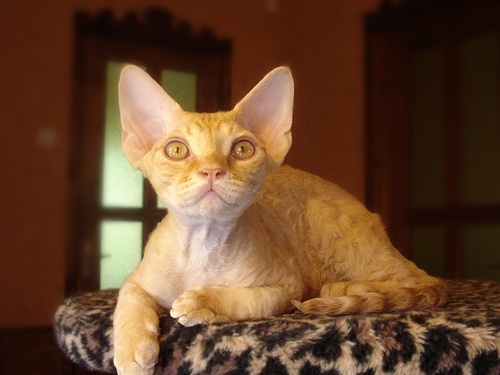



|
Devon Rex Description
The Devon Rex is similar in body to its cousin the Cornish Rex and is the product of the Rex gene II. The Devon Rex has all three hair types, unlike the Cornish, though the guard hairs are sparse. Their coat is denser and in looser waves. The Devon also possesses a fuller body, squarer head and different ears. It is a mid-sized cat, ranging in size from 6-9 pounds with males being heavier than females. An even, full coat of loose curls is ideal for show, but coats can range from shaggy mops to short and so tight they make the cat appear bare. They are easily recognized by their 'elfin' like faces created by a modified wedge head with three distinctive curves: outer edge of ears, cheek bones, and whisker pads. The face should be full-cheeked, the muzzle short and well developed with a strong chin. Eyes should be large and wide set, oval in shape and any color. The ears should be strikingly large and set very low on the head, tapering into rounded tops that are covered in a fine fur.
The body of the Devon should be hard and muscular but slender and medium in length, with medium fine but sturdy legs that are long and slim, ending in small, oval paws. The cat should be well covered with fur, the greatest density of which should be on the back, sides, tail, legs, face, and ears. Bare patches are not permitted in show, however it is important that a downy covering on the belly not be considered bare. The coat should be fine and full-bodied, rexed and soft. It should be short on the back, sides, and upper legs, and very short on the head, neck, ears, paws, chest and tummy. The rippled effect of the fur should be apparent when smoothed with a hand. The Devon Rex comes in more than 70 colors and patterns.
Devon Rex Temperament
The Devon Rex is a highly active and playful breed the loves to be involved in everything. They powerful jumpers and fantastic cuddlers. They want to be wherever people are, especially during meal times. But watch out! If given a chance, the Devon Rex will steal the food right out of your mouth! A Devon Rex will even brave the water of a shower to be near you. They are a good cat for those with mild allergies, as they are not prone to large shedding, however those with severe allergies should be cautious as they still have dander and secrete the enzyme Fel d1.
You may be delighted to hear your Devon Rex talking to the birds outside the window in a variety of chortles and coos, as they wag their tails happily.
Devon Rex Care
The Devon Rex is very easy to care for, they require little grooming. An occasional ear cleaning may be required.
Devon Rex History
The Devon Rex was discovered in 1959 by a Miss Beryl Cox who was caring for a pair of strays, one of whom gave birth to a litter of kittens. One kitten was a bit odd, having a curly coat that seemed to come from his father, a curly haired tom that many had seen in the area. This kitten, named Kirlee, became the father of the Devon Rex breed. Reading the paper, Miss Cole was drawn to the plight of the Cornish Rex and contacted a breeder to let them know that she had her own curly haired cutey. The breeder scrambled for the chance to rebuild the Cornish line, and an attempt was made to breed Kirlee only to result in two litters of straight haired kittens. It was decided then, that Kirlee had a different gene and the breed was established as different from the Cornish, having the Rex gene II. Breeding programs for the Devon Rex in North America began in 1968. They were, and are, an incredibly popular breed. Within 12 years a solid breeding program had been created. The gene pool for the DevonRex is quite small, and breeding is a definite labor of love as outcrossed litters take two generations before the gene is shown. Cats must also be blood typed to avoid pregnancy and early life complications. The Devon Rex and Cornish Rex were originally accepted into the CFA under one breed, Rex. They did not receive separate categories until 1979.
|